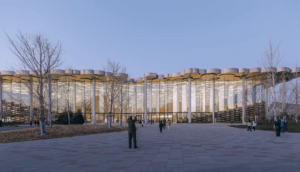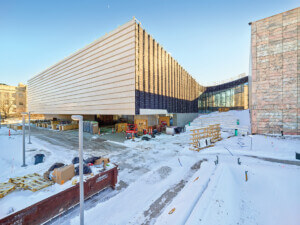Under the banner Let’s Talk About Houses, the second Lisbon Architecture Triennale opened last night in three different venues around the Portuguese capital. A beautifully renovated electric generating plant featured the results of two competitions: one for the low-income immigrant Portuguese community Cova da Moura, and a second for a house in Luanda, Angola. Meanwhile, a second exhibit on artists working in the realm of architecture is being staged at the contemporary Museo do Chiado (I’ll have more on these two shows in a subsequent post). The most ambitious of the three exhibitions, however, is on view at the Museu Coleção Berardo along the city’s architecturally fascinating waterfront in a district called Belem.
Between North and South, as the title of that show suggests, is an exhibition that wants to highlight “housing conditions and new solutions found in various regions of the world.” But it is heavily weighted toward architectural movements and designs in the northern hemisphere, with only a general analysis of urban planning and living conditions in Portugal’s former colonial cities of Recife (Brazil), Luanda (Angola), and Maputo (Mozambique).
The northern hemisphere, as conceived by triennale curator Delfim Sardo, begins with a display—or really recreated installation—of housing proposals by Alison and Peter Smithson regarding the House of the Future, their Valley Section Diagram, and best of all, a document of their Patio and Pavilion project created for the This Is Tomorrow exhibition with photographer Nigel Henderson and Eduardo Paolozzi. I enjoyed these installations, but they seem a slightly arbitrary place to begin a show on northern and southern housing in 2010. Many Portuguese architects, however, claim the Smithsons are little known in the country, and the focus on their “patio and pavilion” concept certainly has a resonance in this Mediterranean-like climate. In any event, rather than focusing on architectural ideas, Sardo smartly preferred to highlight their “inhabitation” by residents. Thus, even in the section on Portuguese housing solutions by Alvaro Siza and Soute de Moura, we are given images of views out of the houses, non-architect designed furniture (the type rarely seen in architectural renderings), and taped conversations by residents of the apartments.
But the show really comes alive when one walks into the section titled The Nordic Connection. Curated by Peter Cook, who predictably goes against the grain of the show, the section features no houses but the most colorful and odd (not a glass box anywhere) collection of wonderfully quirky buildings that capture a new young Scandinavian attitude. Cook’s selection includes a playful, flat-packed, and redeployable adventure playground and a magical children’s camp built into rocks and trees, both by Norway’s Helen & Hard Architects. Snøhetta’s Peter Dass Museum and a bright orange exhibition space in Malmo by Tham & Videgard add to the fun of this exhibition. Unfortunately, the show continues with a deadly boring one-room display of Vittorio Lampugnani’s glass-box Novartis campus in Basel.
The one revelation for a non-Portuguese viewer was the section on SAAL (Servico de Apoio Ambulatorio Local), a government-supported movement of radical architects in Portugal between 1974 and 1976 that brandished the slogan “Houses Yes? Shacks No!” and fought to create better housing for the impoverished population at the time of the Portuguese revolution.
The only problem is that this “utopian” movement really produced very little (none of which was on view in this exhibition) in the way of architecture. Though Alvaro Siza was a participant in SAAL and produced several Porto housing projects credited to the movement, the problem for those who want to deemphasize form in favor of political and cultural analysis and critique is that they often forget architecture. The small part of the exhibition that focused on the southern hemisphere was in fact this type of architectural thinking applied to urban analysis, but while it’s interesting to read on a page and important analytical information, as an exhibition it was barely worth focusing on as a viewer. Had the show started with SAAL as a point of departure to ask all the questions that both formalists and policy analysts in the profession want to focus on today, it would have made a great triennial and Lisbon an important center of architectural thought.










